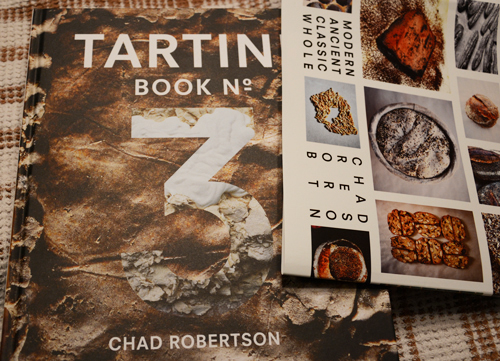Hello everyone and Happy New Year!
A week before Christmas, Chad Robertson's new book, Tartine Book Nº3 arrived – earlier than I was expecting!,
and most welcome :^)
One of the things I really liked about the design of the book was the arrangement of the letters spelling out the author’s name, on the book jacket.
Turned 90º clockwise, the author’s name becomes the number “3” :^)

While I was waiting for the book to arrive, various recipes from the book were popping up online, one of them on the Food52 site – the Oat Porridge bread.
http://food52.com/blog/9376-chad-robertson-s-5-essential-tips-for-baking-bread
http://food52.com/recipes/25384-oat-porridge-bread
The Oat Porridge bread link above includes responses from Mr. Robertson to reader questions – some helpful information there - I’m going to make note of his responses in my book.
And Floyd – you’ll probably like this! – he refers one of the readers to The Fresh Loaf: “…I often direct people to this site http://www.thefreshloaf... and check it myself when I have questions like this. You'll find many excellent bakers posting a ton of knowledge here - lots of it geared towards making professional quality breads in a home kitchen and how to find the best tools to accomplish this.”
:^) !
I really love oat breads, and the description of this bread and its flavor in the book was amazing...very happy to have had the chance to try making this one.
The Oat Porridge bread makes two loaves, so I decided to bake one as I normally would (Nº1) , and one in the recommended baking vessel, a cast iron Dutch oven (Nº2).
The scoring (not so beautiful!) follows the numbering…loaves Nº1 and Nº2, from Nº3 :^)

I like the look of the Dutch oven-baked bread better – I was a little uncertain baking Nº1 at 500F for the full 20 minutes, so backed off the temperature to 450F after 10 minutes; it was also getting a little dark around the edges, so I took it out 10 minutes or so before Nº2.
Crust color for Nº1 suffered as a result, I think.
I scored around the edges of the free-standing loaf, fearing it might blow out being baked cold right out of the fridge.
The scoring pattern was like this  and may partially account for the less-than-round shape after baking?
and may partially account for the less-than-round shape after baking?
When making the dough, I didn’t include the leaven in the autolyse as I wanted to soak the flour for the 4-hour period.
In place of high extraction flour I used locally-grown, whole-milled whole wheat flour, and I added the optional roasted (unblanched) almonds, and almond oil.
The dough I thought very beautiful, the steel-cut oats prevalent, the roasted color of the almonds a pretty accent.

Tasting this bread, the nuts softened but have that wonderful roasted flavor, the crumb is very tender and moist
(50% cooked-until-creamy organic steel-cut oats!), and the flavor is complex – there is a sweetness from the oats as Chad suggests, and caramel flavors from the crust – but also a pepperiness I wasn’t expecting! Very delicious.
Here is the crumb (both loaves had proofed up overnight in the fridge and I baked them from cold as the book instructed…but reading Mr. Robertson’s response to a question about this in the Food52 link above, he recommended a warm-up period after refrigeration at colder ‘home’ refrigerator temperatures – so I will try that next time – and see if the extra proofing helps this bread open up at all…

…it’s going to be a lot of fun working through the breads, sweets and flavors in this book!
For some great photos of Tartine Bakery’s porridge loaf, please see this post from France about her visit to Tartine Bakery,
at Tartine Bread Experiment…Chad’s beautiful bread, and the gorgeous loaves I know France is going to make,
will be my inspiration to keep working at it!
Thank you, Mr. Robertson, for your journey of exploration through these countries, breads and grains; and thank you to all of the talented people who worked to put this book together, as well.
Happy baking everyone!
:^) breadsong